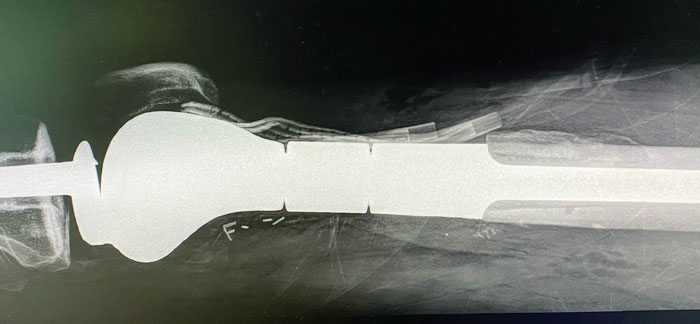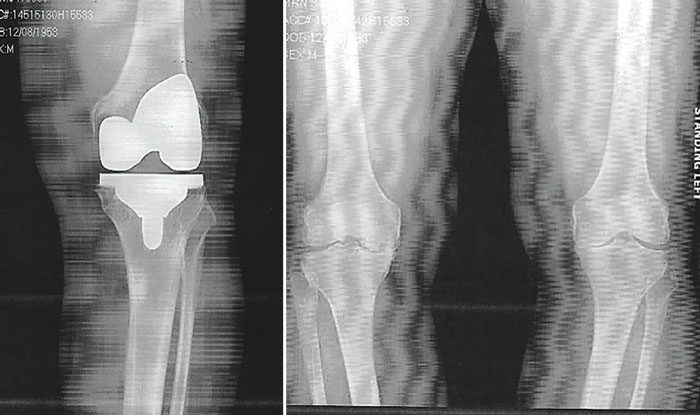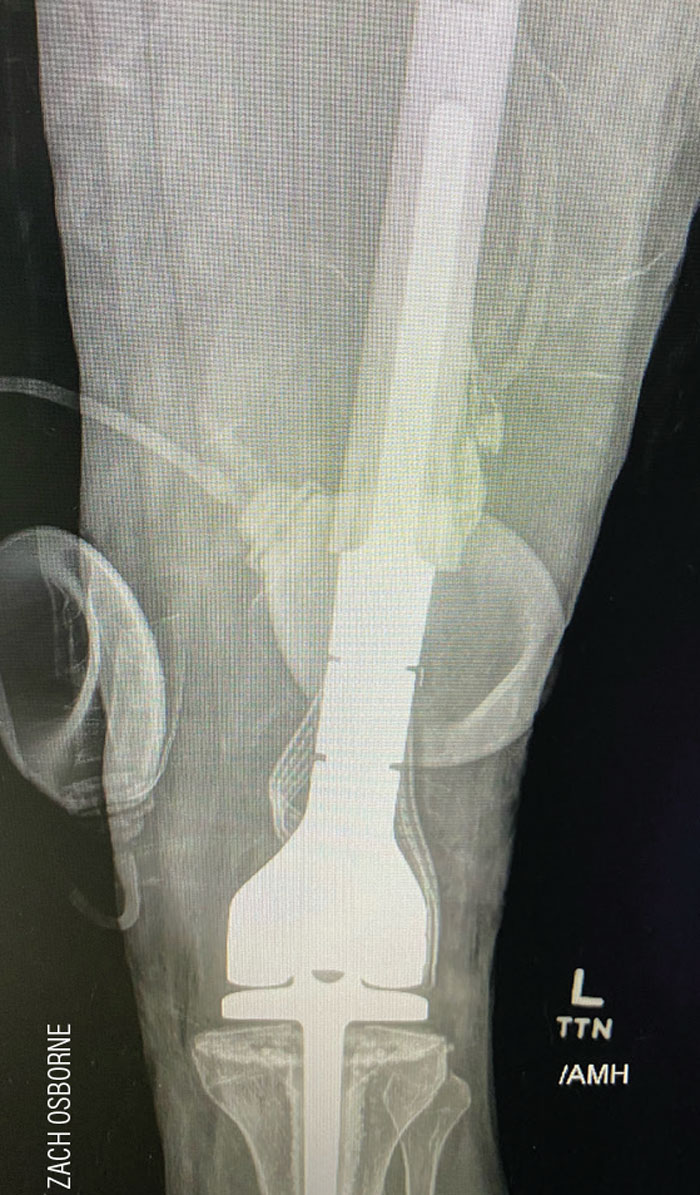Professionals in physically demanding careers, especially the self-employed, often feel invincible. Strength building and physical fitness are simply part of the job. No one thinks a life-changing illness or injury will knock on their door — until it does.
“What we do is dangerous,” Ian Curry says, “and we all take that for granted.”
In August 2022, the Wellington, Fla., farrier flew to a horse show in Michigan for a client. Onsite, another rider asked him to fix a shoe on a hind end. The horse kicked, breaking Curry’s knee in 16 places. The injury required a 2-week hospital stay. He underwent immediate emergency surgery (fasciotomy) to relieve pressure from blood clots. In the months since, he’s needed multiple reconstruction surgeries on his tibia and soft tissue. A year later, he still had limited mobility in his knee — only about 30%.
Takeaways
- Farriers often focus on back pain brought on by repetitive work and fractious horses; however, knee injuries can be equally debilitating and more common than you might think.
- Recovering from knee surgery (or any major injury) is as much a mental mind game as it is physical rehabilitation.
- Saving 6 months to a year’s worth of living expenses can alleviate the financial stress when out of work long-term.
“I was just doing a random favor for a friend,” he says. “Every farrier has bumps, bruises and broken fingers, but this was a giant wake-up call.”
Fellow Wellington farrier Zach Osborne’s knee fracture was not caused by a horse, but required a megaprosthesis reconstruction surgery. Doctors removed nearly 7 inches of his femur and cut off the top of his tibia. A rod runs through the existing femur and tibia bone. At that junction, the rod connects the two pieces to form a rotating hinge joint in place of a knee joint.
“Unlike most knee replacements, my leg needed some time to heal before starting physical therapy,” he says. “I wasn’t able to work for months after the injury and I’m not sure where I will stand as far as long-term with my leg and going back to work as a farrier.”
An unexpected injury is only part of the risk that farriers face. Hoof-care work stresses joints and naturally wears out body parts. This was the case for International Horseshoeing Hall of Fame member Tom Curl. In 2022, the Vero Beach, Fla., farrier celebrated his 50th year working in the trade — a milestone marked by double knee replacement surgery. First, his left knee was replaced on March 14, followed by his right on June 20.
“My knees gave me fits about 3 years ago and I just kept plowing on until the end of last year until I got crippled up,” he says. “I’d get under one and couldn’t stand back up.”
Trimming and shoeing are hard on the body and create a possibility for injury. Stretching, strengthening and choosing the horses you work on can protect your body and reduce the risks. However, there is always a chance that fate steps in and no matter how careful you are, a significant injury can occur.
These three shoers share what they have learned through the process in hopes that if you’re in a similar situation, their advice is helpful.
Physical Road to Recovery
The trio ended up on the operating table under entirely different circumstances. Yet, they share an understanding of how excruciating knee surgery and subsequent recovery can be.
“Physical therapy was tough,” Curry says. “The doctors told me I would never work again or walk unassisted. I found a tough physical therapist who told me, ‘If you want to act like that, that’s fine. But if you want to try, then let’s try.’ I took that attitude and proved the doctors wrong. I still have a limp but am back walking and working.”

Doctors removed nearly 7 inches of Zach Osborne’s femur and the top of his tibia after a knee fracture. A rod runs through the femur and tibia to form a rotating hinge joint in place of a knee joint. Source: Zach Osborne
While Curl’s knee replacement was planned, he suggests planning for a yearlong recovery period.
“Arthritic bone is what causes all that pain in the knees,” he says. “Then when they cut through that kneecap, they cut through a lot of nerves. When those nerves are finding their way back to junction points, it can be painful at times. After surgery, you also find out how much your quad muscles have changed and atrophied when you’ve been using them incorrectly to compensate for pain for so long.”
“What we do is dangerous, and we all take that for granted…”
It’s impossible to predict the unexpected scenario when a horse kicks and blows out your knee. However, working with a doctor, physical therapist, or personal trainer as part of your wellness routine may be able to strengthen your knees to lessen wear and tear on the joints.
Online wellness resource WebMD.com suggests the following common exercises, which focus on your knees.
Wall squats. Position your back against a wall and stand with your feet shoulder-width apart. Slowly bend your knees to about 90 degrees and hold for 5-10 seconds. Repeat and gradually extend the hold.
Heel raises. Stand flat on the floor, use a small ledge or a stop on the stairs. Raise on your toes so your heels come off the ground. Complete 10 to 15 and repeat.
Step-ups. Position yourself with one foot on a sturdy step — it could be a 2x4 or the bottom step on a staircase. Bend one knee and step to the floor with your opposite foot. Stand back up and repeat 10 to 15 times on the same side and then swap legs. Increase the intensity with a higher platform.
Swimming. If you’re also looking to add cardio to your fitness routine, swimming or jogging in water is a low-impact workout that also strengthens your knees.
Cost of Knee Surgery
It ain’t cheap. The last time Curry reviewed his medical bills, they totaled $750,000. With additional visits and services since then, he estimates costs will hit or surpass $1 million by the end of the first year.
Curl’s knee replacement surgeries cost between $60,000 to $80,000. That’s not including travel to and from the Carroll Clinic in Texas, where he chose to have his surgery because of its reputation for working with the Dallas Cowboys football team. Flights, extended hotel stays and meals on the road increased expenses. Flying after surgery increases the chances of post-surgery blood clots, so extra time is needed to reduce those risks.
Few people have access to that much cash to cover that level of expenses. Yet, despite being laid up for 9 months, Curry’s business never missed a beat.
“I admit I was guilty of not having disability insurance until about 9 years ago,” he says. “But I run my business like a business and keep debt low, so my monthly nut is less than $3,000.”
Curry had first-hand experience of what happens when you don’t. His father was a business owner who mortgaged everything. The family lost everything when a machine ran over his father and put him out of work.
“I grew up dirt poor and decided I wasn’t ever going back to that early on,” he says. “I focused on keeping debt low and saving to avoid losing everything I worked for from an accident.”
Curl was in a slightly different situation due to his age. The 69-year-old didn’t have disability insurance but qualifies for Medicare, which covered a significant portion of the expense. His wife is a carded horse show judge, and their collective travel racked up millions of airline miles, so his flights were essentially “free.” He is also at a place in his career where he is debt-free.
“I suggest having 6 months to a year of income saved…”
Business savvy, running on a lean budget and savings have been as important as insurance in helping these farriers worry less about their finances during recovery.
It’s not uncommon to hear farriers lament that they are up to their eyeballs in mortgages and truck payments. Working for high-dollar clients can also encourage a “living large” mentality of easy spending on trucks, “toys” and supplies.
“A lot of younger farriers will buy something because they went to a clinic and recommended or have seen somebody else use it,” Curl says. “Only buying what you need helps in a big way. Many farriers miss the boat by not getting together and buying case lots that can take advantage of discounted pricing. I buy cases of glue at a time and split it with some people, which helps everybody.”
Curry, Osborne and Curl agree that setting aside savings is as critical as having a book of clients or the needed supplies to do the work. Curl recommends having enough cash available to cover a full year of bills.
Learn More Online
Gain more insight into preventing and rehabbing horseshoeing-related injuries by:
“I certainly suggest having 9 months to a year of income saved,” Osborne says. “It’s easier said than done, but should become a real goal for anyone in our line of work.”
Relationships with other farriers are equally vital in a time of need. Shoers from Kentucky and Texas traveled to Michigan to finish out the show in Curry’s place. None would accept payment. In recent years, he has also employed between two and four farriers.
“Do favors for other guys and they’ll be ready to volunteer when you need help,” he says. “My philosophy with my guys always has been to take care of them first. It paid off because they have taken care of me by keeping the business running.”
The Mental Game
The physical pain and financial stress alone can be overwhelming, but many people tend to overlook the mental toll an injury of this nature can take. For example, Daylon Swearingen, the 2022 Professional Bull Rider (PBR) World Champion, underwent shoulder surgery early in 2021. In multiple media interviews, he points to the mental mindset as being a critical aspect of recovery and getting back to work in a risky sport.
“A lot of young guys think they are Tarzan because they got this account or that account,” Curl says. “But the first day you’re in surgery, that client is going to call someone else. After that, you’re as replaceable as the plumber.”
That can take a toll on any person’s confidence and mental health. Recognizing those feelings of isolation, Curl reached out to both Curry and Osborne after learning of their injuries. The trio calls and texts regularly to boost one another’s morale throughout the rehabilitation and recovery process.
“Only buying what you need helps in a big way…”
“We send each other pictures of this or that and talk about a lot of things, even cooking — we’re all really good cooks,” Curl says. “We’ve all scheduled a day last fall to meet and cook together.”
“It’s also important to remain optimistic,” Osborne adds. “It weighs on your mind when you’re used to running out the door every day and being productive. I also suggest having a community of farriers around yourself and never hesitate to give anyone a hand because someday you may be the one who needs it.”
Listen to Your Gut
Gut instinct can be your most powerful ally in protecting your health and financial security. Ignoring that nagging feeling — especially when it feels unexplained can be costly. Curry’s gut spoke to him twice — once he listened, the other time he ignored it. The first time it spoke, he decided to increase his health insurance coverage a month before the injury. Then, in Michigan, he knew he should not have touched the horse that dealt that fateful blow.
“That horse gave me a bad vibe,” he says. “The people told me he was fine. I listened to them and got hurt.”
But the best phone call he ever received came while he was in the hospital the day after he got hurt. His office manager told him he didn’t have to worry about a thing. Following his gut and having a financial plan meant he could run his business, pay his bills and not miss a beat for the next year if he could not work.
“I would have lost everything I had worked for, otherwise,” he says.










Post a comment
Report Abusive Comment